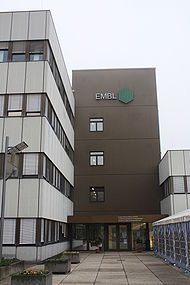
European Molecular Biology Laboratory
Encyclopedia
The European Molecular Biology Laboratory (EMBL) is a molecular biology
research institution supported by 20 European countries and Australia as associate member state. EMBL was created in 1974 and is an intergovernmental organisation funded by public research money from its member states. Research at EMBL is conducted by approximately 85 independent groups covering the spectrum of molecular biology. The Laboratory operates from five sites: the main Laboratory in Heidelberg, and Outstations in Hinxton (the European Bioinformatics Institute
(EBI)), Grenoble, Hamburg, and Monterotondo near Rome.
 Each of the sites has a specific research field. The EBI
Each of the sites has a specific research field. The EBI
is a hub for bioinformatic research and services, developing and maintaining a large number of databases which are free of charge for the scientific community. At Grenoble and Hamburg, research is focused on structural biology. EMBL's dedicated Mouse Biology Unit is located in Monterotondo. At the headquarters in Heidelberg, there are units in Cell Biology and Biophysics, Developmental Biology, Genome Biology and Structural and Computational Biology as well as service groups complementing the aforementioned research fields.
Many scientific breakthroughs have been made at EMBL, most notably the first systematic genetic analysis of embryonic development in the fruit fly by Christiane Nüsslein-Volhard
and Eric Wieschaus, for which they were awarded the Nobel Prize for Medicine in 1995.
Molecular biology
Molecular biology is the branch of biology that deals with the molecular basis of biological activity. This field overlaps with other areas of biology and chemistry, particularly genetics and biochemistry...
research institution supported by 20 European countries and Australia as associate member state. EMBL was created in 1974 and is an intergovernmental organisation funded by public research money from its member states. Research at EMBL is conducted by approximately 85 independent groups covering the spectrum of molecular biology. The Laboratory operates from five sites: the main Laboratory in Heidelberg, and Outstations in Hinxton (the European Bioinformatics Institute
European Bioinformatics Institute
The European Bioinformatics Institute is a centre for research and services in bioinformatics, and is part of European Molecular Biology Laboratory...
(EBI)), Grenoble, Hamburg, and Monterotondo near Rome.
Research at EMBL

European Bioinformatics Institute
The European Bioinformatics Institute is a centre for research and services in bioinformatics, and is part of European Molecular Biology Laboratory...
is a hub for bioinformatic research and services, developing and maintaining a large number of databases which are free of charge for the scientific community. At Grenoble and Hamburg, research is focused on structural biology. EMBL's dedicated Mouse Biology Unit is located in Monterotondo. At the headquarters in Heidelberg, there are units in Cell Biology and Biophysics, Developmental Biology, Genome Biology and Structural and Computational Biology as well as service groups complementing the aforementioned research fields.
Many scientific breakthroughs have been made at EMBL, most notably the first systematic genetic analysis of embryonic development in the fruit fly by Christiane Nüsslein-Volhard
Christiane Nüsslein-Volhard
Christiane Nüsslein-Volhard is a German biologist who won the Albert Lasker Award for Basic Medical Research in 1991 and the Nobel Prize in Physiology or Medicine in 1995, together with Eric Wieschaus and Edward B...
and Eric Wieschaus, for which they were awarded the Nobel Prize for Medicine in 1995.
Mission
The cornerstones of EMBL's mission are manifold. Basic research in molecular biology and molecular medicine is performed; scientists, students and visitors at all levels are trained; vital services to scientists in the member states are offered; new instruments and methods in the life sciences are developed; and there is an active engagement in technology transfer.Training
Advanced training is one of EMBL's four core missions. Over the years, the Laboratory has established a number of training activities, of which the International PhD Programme is the flagship - it has a student body of about 200, and since 1997 has had the right to award its own degree. Other activities include the postdoctoral programme, including the EMBL Interdisciplinary Postdoctoral programme (EIPOD); the European Learning Laboratory for the Life Sciences (ELLS) for teacher training; and the Visitor Programme.EMBL Advanced Training Centre
In March 2010, the EMBL Advanced Training Centre (ATC) was inaugurated on the main campus in Heidelberg. Shaped in the form of a double helix, it hosts world-class conferences and provides state-of-the-art training opportunities.Science and Society
EMBL also runs an active Science and Society Programme which offers activities and events on current questions in life science research for the general public and the scientific community.See also
- European Molecular Biology OrganizationEuropean Molecular Biology OrganizationEMBO stands for excellence in the life sciences. The EMBO mission is to enable the best science by supporting talented researchers, stimulating scientific exchange and advancing policies for a world-class European research environment....
(EMBO) - John KendrewJohn KendrewSir John Cowdery Kendrew, CBE, FRS was an English biochemist and crystallographer who shared the 1962 Nobel Prize in Chemistry with Max Perutz; their group in the Cavendish Laboratory investigated the structure of heme-containing proteins.-Biography:He was born in Oxford, son of Wilford George...
- Fotis KafatosFotis KafatosFotis Constantine Kafatos is a Greek molecular entomologist. Between 2005-2010 he was the founding president of the European Research Council and member of its Scientific Council...
- Leó SzilárdLeó SzilárdLeó Szilárd was an Austro-Hungarian physicist and inventor who conceived the nuclear chain reaction in 1933, patented the idea of a nuclear reactor with Enrico Fermi, and in late 1939 wrote the letter for Albert Einstein's signature that resulted in the Manhattan Project that built the atomic bomb...
- Matthias HentzeMatthias HentzeMatthias W. Hentze is a German scientist.- Biography :Hentze obtained his Abitur from the Ratsgymnasium in Rheda-Wiedenbrück in 1978. He studied medicine at the Westfälische Wilhelms-Universität in Münster, Germany, and at the Medical Schools of Southampton, Oxford, Glasgow, and Cambridge, UK...

